The following blog began its existence as an assignment for a university course in technical writing. My job was to write an instruction manual describing a simple process; I chose to describe how to eat a banana.
Although it's not a Gwendle story, I'm sharing it on Gwendle Vs Everything because a few years later, this assignment was my inspiration for making my blogs more visually interesting by illustrating them with stick figures. The version below has been expanded and re-formatted.
Introduction:
The banana is a tropical fruit with a thick, inedible peel. Inside that peel is the banana's soft, sweet flesh, which is suitable for consumption by most humans. Bananas contain dietary fiber, and a long list of nutrients including potassium, magnesium, phosphorous, calcium, selenium, iron, folate, niacin, pantothenic acid, and vitamins A, B6, C, and E.
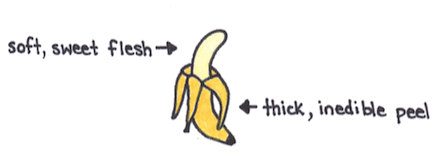
In addition to being a good source of nutrients, a banana is an effective (and some say tasty) way to alleviate mild hunger.
The ripeness of a banana can be determined by its colour. The perfectly ripe banana is often described as one on which the peel is uniformly yellow, with no traces of under-ripe green or over-ripe brown. However, some individuals may prefer a banana that is slightly under- or over-ripe because of its flavour or texture: choose the banana that is right for you.
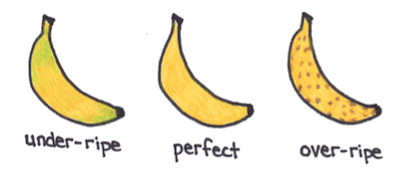
Before attempting to eat a banana in the manner described below, there are a few things that you will need:
Hunger
A banana of sufficient ripeness
A desire to benefit from the banana's nutrients, or its flavour, or both
2 hands
A mouth containing a tongue, and preferably containing teeth (although the banana's soft texture may make teeth optional)
The ability to swallow
A working digestive system
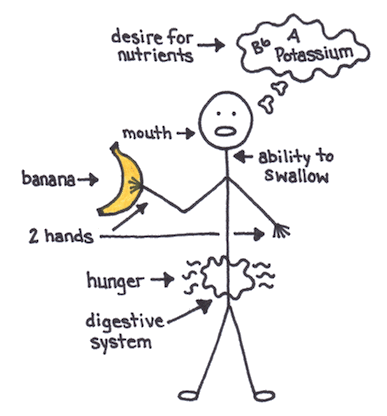
CAUTION: Do not attempt to eat a banana if you lack a working digestive system including the ability to chew and swallow soft foods. Small children, people with limited dexterity, and people who do not have the use of two hands may need to modify these instructions or ask for assistance. These instructions are not intended for people who are allergic to bananas.
Section I: Peeling the Banana
Once you've decided to eat a banana, the first step is to remove the peel.
Be careful not to grip the banana too firmly.

Hold the banana gently but securely in one hand, and grasp the stem of the banana with your other hand (Figure 1).
Bend the stem of the banana where it meets the top of the banana until a break forms in the peel (Figure 2).
Pull the stem down the length of the banana; this will result in removing a section of the banana's peel from the fruit within. To continue peeling your banana, use your thumb and index finger to grip the top edge of the peel that is still adhered to the banana and pull downward (Figure 3).
Repeat steps 2 and 3 until the edible fruit is exposed on all sides.
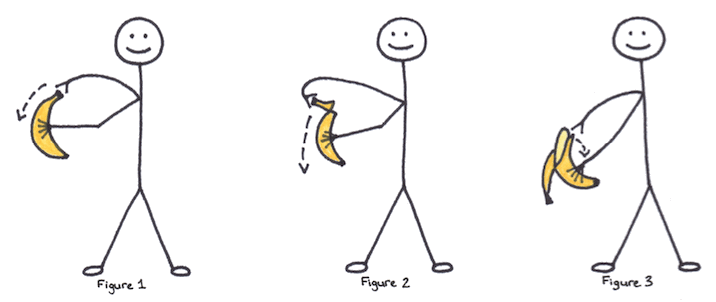
Please note that although some people prefer to remove the entire peel at once, others prefer to pull the strips down in stages, leaving part of the peel on the fruit as a means of holding the soft banana without squishing it. These instructions assume that you will take the later approach to peel removal. If you prefer to take the former approach, reverse the order of steps II and III.
Section II: Consuming the Banana
Once your banana has been peeled it is ready for consumption. In your excitement, you may be tempted to raise the peeled fruit to your mouth and take a bite . . .
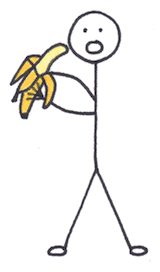
Unfortunately, we live in a post-Freudian society where some people think that things represent other things. Because of this, your desire for and consumption of a banana may be misinterpreted.
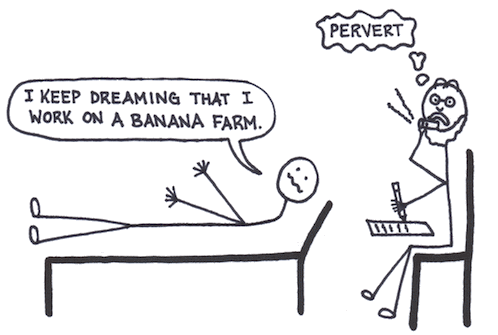
Trying to enjoy your banana in mixed company may cause a socially awkward situation . . .

. . . and lead to undesirable consequences.
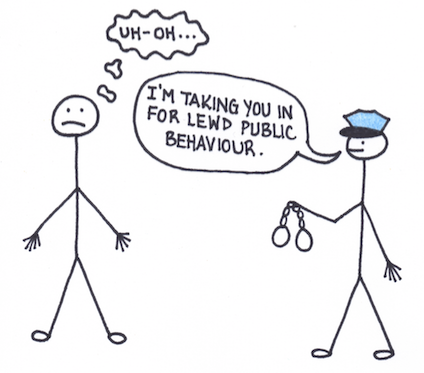
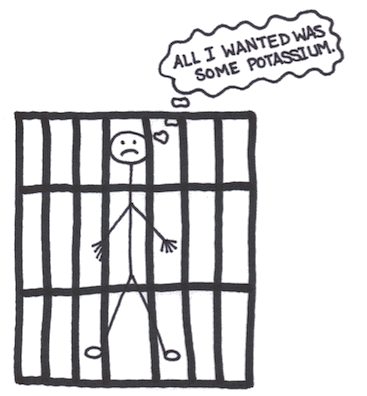
While it's possible that the authorities won't get involved, the social awkwardness may still cause unwanted gossip and ongoing embarrassment.
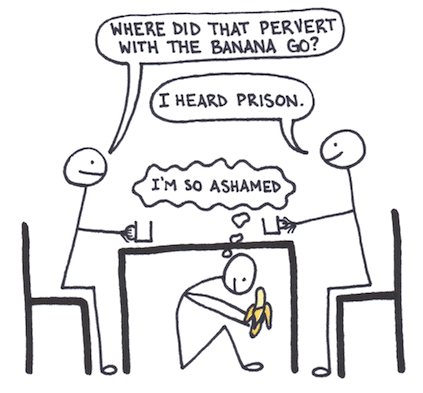
To avoid this common social misstep, the following method of banana consumption is recommended:
Grasp the top of the banana between the thumb and two or three fingers of one hand (the "working" hand), while holding the partially peeled banana gently but securely in your other hand.
Turn the working hand approximately 90°, and break off a bite‐sized piece of the banana (Figure 1).
Raise your working hand to your mouth.
Put the entire bite‐sized piece of banana into your mouth (Figure 2).
Chew and swallow the piece of banana. Enjoy its flavour and nutrients (Figure 3).
As necessary, continue to peel the banana in increments, exposing more of the edible fruit.
Repeat steps 1 through 6 until the entire banana has been consumed.
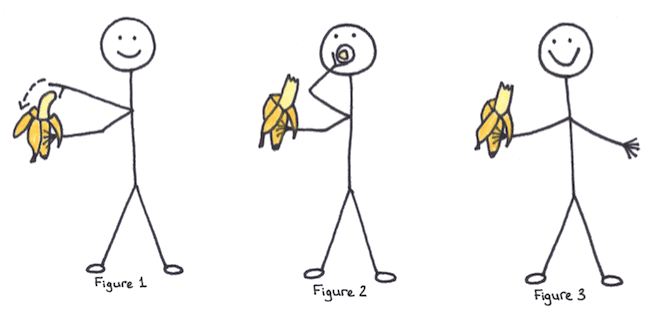
Section III: Discarding the Banana Peel
Hooray! You've successfully eaten your banana without any trace of social awkwardness! But what should you do with the thick, inedible peel?
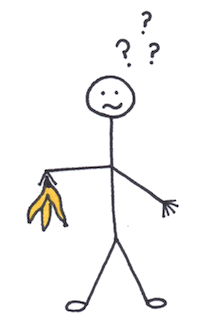
There are many options, but not all of them are good.
The most obvious solution is to dispose of your banana peel in an appropriate waste receptacle, but that may not be as easy as it first appears. This isn't the '80s, and you won't win any points for putting your peel into a regular garbage destined for landfill.

You may be tempted to throw your banana peel on the ground. After all, it's not really littering. The peel is biodegradable. It will decompose naturally. Right?
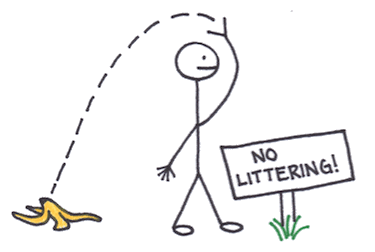
No. Throwing your garbage on the ground is not the same as composting. Stop making excuses for the fact that you're lazy.
Besides, if cartoons have taught us anything, it's that banana peels are extremely dangerous.
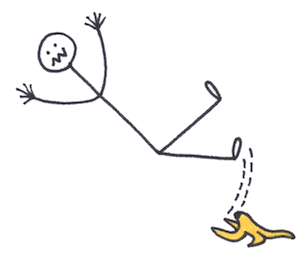
And there are consequences when you just leave them lying around.
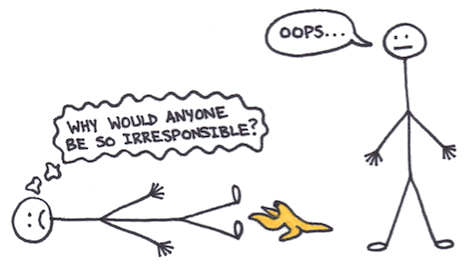
The best place for your empty banana peel is in the compost bin. No one will get mad at you for putting it there.

Conclusion:
You can now eat bananas and dispose of their peels confidently, without any fear of social awkwardness.
To learn more about bananas, visit your local library.

